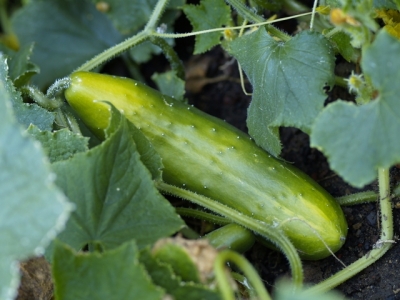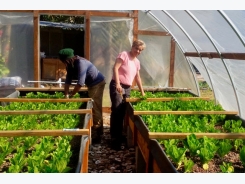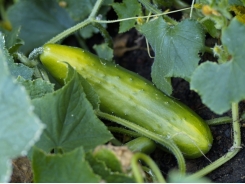Growing Cucumbers

Cucumis sativus is frequently grown commercially, like the tomato, in a single cordon, but is unlikely to be so treated by the majority of gardeners. The following method of culture will be found satisfactory on either a large or small scale.
Early crops should only be attempted in areas of good natural light and in a well-constructed greenhouse of good design. Cucumbers are lovers of warmth, demanding a minimum of 19°C (66°F) for optimum production, although they will produce worthwhile crops on a smaller scale at lower temperatures. Cucumbers are frequently grown on an amateur scale as a “follow-on” short-season crop subsequent to general propagating activities when the outside temperature levels are sufficiently high to avoid the high cost of heating necessary for early crops.
Contents:
- Growing Cucumbers
- Programme of production
- Seed sowing and germination
- Treatment of young plants
- Artificial illumination
- Preparation of beds
- Programme of production
Earliest crop:
- Propagation period: About 8 weeks period
- Sow seed: From mid autumn in very good light areas until early winter in poor light areas
- Potting on: 7-10 days after germination (or sooner)
- Planting: from early winter until late winter
- Cropping: late winter/early spring until early autumn
Mid-season crop:
- Propagation period: 6-7 weeks
- Sow seed: throughout mid winter
- Potting on: 7-8 days after germination (sooner if necessary)
- Planting: throughout early spring
- Cropping: Early summer onwards
Late crop:
- Propagation period: 4-5 weeks
- Sow seed: Late winter — early
- Potting on: Spring
- Planting: 2-5 days later – Mid spring (until late spring for frames)
- Cropping: Mid summer — mid autumn
Seed sowing and germination
It is essential to observe almost clinical hygiene throughout the propagation stage of cucumbers, since they are extremely susceptible to infection by weak parasitic diseases. Good light is highly desirable for cucumber propagation, which means very clean glass to admit maximum light.
The compost for seed sowing should be absolutely clean, porous and free-draining, necessitating the use of coarse grit to give good aeration. All materials including pots should be sterilized by washing in disinfectant.
It is now general practice to sow the seeds, usually sold by number, individually in paper tubes or peat pots and plant up in 11-13cm (4-½ – 5in) pots when large enough, thus avoiding root disturbance and damage. On a larger scale seeds can be sown in seed trays, 40-48 per box, for potting direct into 11-13cm (4-5in) peat or paper pots thereafter.
Use plump seeds only (flat ones being discarded) and cover with 1cm (1/2in) layer of compost. It matters little whether the seeds are placed flat, on their sides, or with the pointed end downwards; a convenient method for the amateur is to push them into the compost with the finger and thumb.
A temperature of 27°C (80°F) to ensure quick and even germination is desirable, although lower temperatures, down to 21°C (70°F), will give fair although more erratic results. Lower temperatures than this tend to give patchy germination, a lot depending on variety. Once sown, the seeds are covered with black polythene or paper and glass. Germination usually occurs with viable seed in about two days at higher temperatures and in up to four days at lower temperatures. Germinating cabinets can be used. Immediately the cotyledon appears the little plants should be given maximum light. A practice still followed by some gardeners is to germinate seeds in between thick blotting paper kept thoroughly soaked in a shallow tray, at a temperature of 27°C (80°F), the seedlings being potted up with tweezers immediately.
NOTE: Root stock Cucurbita ficifolia is available for grafting varieties on to, and imparts resistance to wilt disease. Grafting procedure is similar to that described for tomatoes. Sow root stock seed earlier than the variety.
Treatment of young plants
The potting sequence varies, but the following is a summary of the accepted procedure.
Box sown plants Potted in 8cm (3in) pots 7-10
days after germination in winter, or 2-5 days in spring.
After 10-14 days the plants are potted on in (4-½-5in) pots
Small pot sown After 10-14 days potted in 11 -13cm (4-1/2-5in) pots
Large pot sown This method is used for late sowing and avoids all re-potting
Some gardeners sow the seed direct into 15-18cm (6-7in) pots to enable the plants to be housed for a longer period in propagating temperatures. The temperature during the propagating stage (excluding germination) should be 21°C (70°F) day, 18°C (66°F) night, ventilating at 26°C (80°F).
Composts for potting
John Innes No 1 in winter and up to John Innes No 2 in spring is usual, although peat or peat/sand mixes can be equally satisfactory. Plants must be handled with extreme care, the compost being firmed up only loosely. Plants are put closely together to begin with, and finally spaced out to 30 x 30cm (12 x 12in). They are ready for setting out when the roots are sufficiently developed to avoid disintegration of the root ball. Open benches have been shown to be more successful than solid benches for cucumber propagation.
Feeding
Plants may require feeding in John Innes compost, particularly towards the end of the propagating period; with soilless mixes feeding is essential, using either proprietary feeds or home-made feeds at a dilution rate of 1:400 (not 1:200 as for tomatoes).
Artificial illumination
The need to use supplementary lighting depends on time of year and natural light levels. When conditions are poor, cucumbers with their very large leaves will respond reasonably well to artificial light, which may shorten the propagation period considerably.
Specification of supplementary lighting HLRG mercury fluorescent reflector lamps 75cm (2.5ft) above bench, 1.2m (4ft) apart. Alternatively MBFR/U lamps suspended 90cm (aft) above bench at 1.2m (4ft) apart can be used. All types of lamp can either be permanently fixed or on a sliding rail to allow batch treatment. Either type will cover 200 seedlings. Fluorescent tubes can also be used and in fact are the main source of lighting by commercial growers SungroLites have a very useful application here. Lighting period should not be in excess of 17 hours in each 24, the plants having 7 hours of darkness daily over a period of 14-20 days. (In experimental work plants treated for longer have responded well.) A 12 hour lighting cycle, the lights being changed at 10.00 hours and 22.00 hours, gives two batches their share of supplementary light. The plants are placed under the lights when the seed leaves or cotyledons are fully open.
Enrichment with carbon dioxide
There is insufficient evidence to show that CO2 enrichment is of great assistance during the propagation period, although it can certainly be experimented with, particularly in areas of good light.
Preparation of beds
Cucumbers are most successfully grown in beds raised above the ground soil level, as this ensures good drainage and soil airation.
For commercial growing soil sterilization by one or other of the sterilization methods (link to soil sterilization) will be necessary, while on a smaller scale special beds or straw bales will be used and the need for sterilization diminishes. Whatever soil is used must be sterilized or clean, there being much to be said for a good loam derived from stacked turf put through a 0.6cm (1/4in) riddle.
Beds must be made up on an area of perfect drainage, which may involve the incorporation of very coarse sand or gravel through the border soil below the selected bed area. The farmyard manure selected should preferably be from a farm where the animals are straw bedded, avoiding if possible manure containing wood shavings or peat, particularly the former. The first layer of manure is spread on the ground 15cm (6in) deep and about 50-60m (20— 24in) wide, followed by 10cm (4in) of soil; further layers of manure and soil are added. The beds should be about 50cm (20in) high with straight sides and a flat top. The beds are prepared about 2 weeks ahead of planting and watered for 7-10 days before planting, to induce fermentation and rapid release of ammonia. The temperature of the beds will rise quickly and planting can commence when it has fallen to about 27-32°C (80-90°F).
Straw bales and wads
The procedure for straw bale fermentation is very similar to that described for tomatoes. Many gardeners thoroughly soak the bales over a period of around 3 weeks or so before the intended planting date, applying 680g (1-1/2lb) of ammonium nitrate lime after the straw is wet, followed by another 454g (1lb) in 3 days and a further 680g (1-1/2lb) of a complete slow-release trace-element-containing fertilizer, the above being quantities per 50kg (cwt) of dry straw. Cucumbers appear more susceptible to salt damage than tomatoes, necessitating caution when ammonium nitrate lime is applied, although owing to the varying nature of the straw, plants can suffer from nitrogen deficiency when insufficient nitrogen has been applied during the fermentation process. At all events, the fertilizer applications are watered in thoroughly. A check should be kept on the temperature of the bales, planting commencing when the temperature of the inside of the bales has dropped to about 27-32°C (80-90°F).
Straw wads 20-25cm (8-10in) wide can be used, applying the fertilizer pro rata to the total quantity of straw used. As with tomatoes, organic gardening enthusiasts should use organic based liquid fertilizers such as Maxicrop Tomato Special for the fermentation process.
Isolated beds
Several systems are involved here, the main criteria being to isolate the beds from pests and diseases contained in the greenhouse border by using large clay pots, 23cm (9in) whale-hide pots, bolsters (growbags) or conveniently designed boxes, rockwool, peat, wood pulp or straw blocks. But good aeration and drainage are necessary or fungal diseases may attack. Rockwool, NFT, Perlite and other specialist systems require advice.
Related news
Tools

Phối trộn thức ăn chăn nuôi

Pha dung dịch thủy canh

Định mức cho tôm ăn

Phối trộn phân bón NPK

Xác định tỷ lệ tôm sống

Chuyển đổi đơn vị phân bón

Xác định công suất sục khí

Chuyển đổi đơn vị tôm

Tính diện tích nhà kính

Tính thể tích ao




 Expert Tips for Growing Garden Tomatoes – Straw…
Expert Tips for Growing Garden Tomatoes – Straw…  Growing Cucumbers and Gherkins in the Vegetable Garden
Growing Cucumbers and Gherkins in the Vegetable Garden